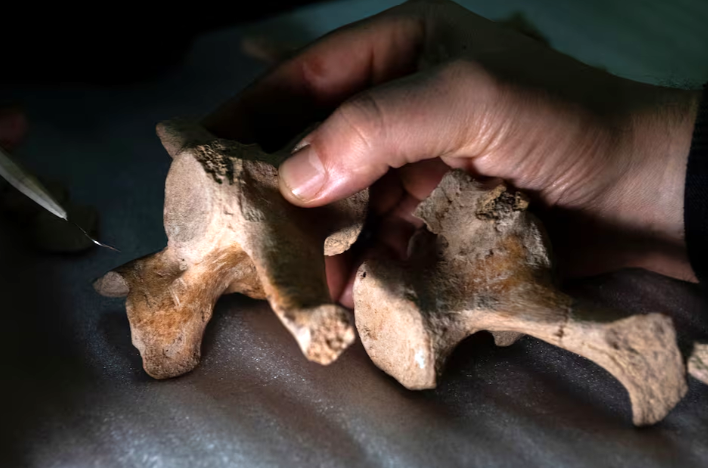
Evidence for earliest human presence revealed in southern South America
Fossil bones found in Argentina of a large armadillo relative with cut marks suggestive of butchering indicate humans were present in southern South America some 21,000 years ago, according to researchers, earlier than previously thought. The bones were from a large armored plant-eating mammal named Neosclerocalyptus, part of a group called glyptodonts that inhabited the Americas for more than 30 million years before going extinct at the end of the Ice Age about 10,000 years ago. The researchers said the cut marks on the bones appear to have been made by people using stone tools. That represents strong evidence for the presence of our species, Homo sapiens, though no human fossils were found at the site, they added. Glyptodonts are related to modern-day armadillos, though much larger - some species as big as a small car. They had a large, bony carapace that covered much of the body - resembling a turtle shell - as well as armor atop the head, a large and strongly built tail and short limbs. Neosclerocalyptus was one of the smaller species. The individual in this study was about 6 feet long (180 cm) and roughly 660 pounds (300 kilograms). The marks on the bones were found on the pelvis, tail and body armor. "The placement of these cut marks is consistent with a butchering sequence that targets areas of dense flesh, that is, the cut marks were not randomly distributed but focused on those skeletal elements that harbored large muscle packs like the pelvis and the tail. This is a typical pattern observed during a butchering process," said anthropologist Miguel Delgado of National University of La Plata, senior author of the study published on Wednesday in the journal PLOS ONE The shapes of the cut marks are consistent with those created using types of stone tools called flakes and hammerstones, Delgado added. Anthropologist and study lead author Mariano del Papa of National University of La Plata said that "the only ones capable of making them (these marks) were humans." The timeline for the peopling of the Americas has been a matter of debate, with some recent discoveries indicating humans had arrived much earlier than previously thought. The role of people in the extinction of many large mammals in the Americas also has been a subject of controversy. The Neosclerocalyptus fossils are among the oldest evidence of human interaction with these large Ice Age animals.

Fossil bones found in Argentina of a large armadillo relative with cut marks suggestive of butchering indicate humans were present in southern South America some 21,000 years ago, according to researchers, earlier than previously thought. The bones were from a large armored plant-eating mammal named Neosclerocalyptus, part of a group called glyptodonts that inhabited the Americas for more than 30 million years before going extinct at the end of the Ice Age about 10,000 years ago. The researchers said the cut marks on the bones appear to have been made by people using stone tools. That represents strong evidence for the presence of our species, Homo sapiens, though no human fossils were found at the site, they added. Glyptodonts are related to modern-day armadillos, though much larger - some species as big as a small car. They had a large, bony carapace that covered much of the body - resembling a turtle shell - as well as armor atop the head, a large and strongly built tail and short limbs. Neosclerocalyptus was one of the smaller species. The individual in this study was about 6 feet long (180 cm) and roughly 660 pounds (300 kilograms). The marks on the bones were found on the pelvis, tail and body armor. "The placement of these cut marks is consistent with a butchering sequence that targets areas of dense flesh, that is, the cut marks were not randomly distributed but focused on those skeletal elements that harbored large muscle packs like the pelvis and the tail. This is a typical pattern observed during a butchering process," said anthropologist Miguel Delgado of National University of La Plata, senior author of the study published on Wednesday in the journal PLOS ONE The shapes of the cut marks are consistent with those created using types of stone tools called flakes and hammerstones, Delgado added. Anthropologist and study lead author Mariano del Papa of National University of La Plata said that "the only ones capable of making them (these marks) were humans." The timeline for the peopling of the Americas has been a matter of debate, with some recent discoveries indicating humans had arrived much earlier than previously thought. The role of people in the extinction of many large mammals in the Americas also has been a subject of controversy. The Neosclerocalyptus fossils are among the oldest evidence of human interaction with these large Ice Age animals.
